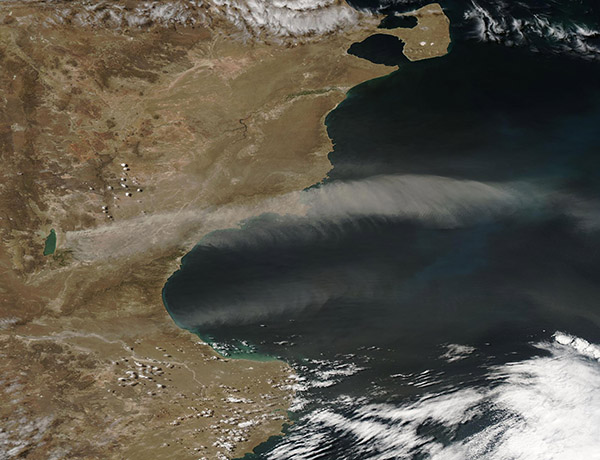Images
February 9, 2024 - Large Plume of Dust from Lake Colhué Huapí
Tweet
A low-pressure system over the South Atlantic Ocean stirred up intense winds that lifted dust from Lake Colhué Huapí, Argentina in early February 2024. The Moderate Resolution Imaging Spectroradiometer (MODIS) on NASA’s Aqua satellite captured a long plume of airborne dust on February 7. At that time, a thick plume of tan dust stretched for more than 350 miles (560 kilometers) eastward, passing over the Gulf of San Jorge and the Argentine Sea.
Lake Colhué Huapí is a shallow, silt-laden lake that sits east of the larger Lake Musters. With a depth of about 20 meters (65.6 feet), the blue waters of Lake Musters are easily visible from space. In contrast, Lake Colhué Huapí sits in a shallow, dusty depression and is only about 2 meters (6.6 feet) deep. In hot, dry summer weather, the water levels often drop even further, making Lake Colhué Huapí the largest and most active source of dust storms in the region.
Dust storms from Lake Colhué Huapí peak during summer (December through March), although events also can occur in the winter (May through August). Dust from this lake can be transported from the westerlies as far away as East Antarctica and may also provide nutrients that may trigger blooms of phytoplankton in the South Atlantic Ocean.
Image Facts
Satellite:
Aqua
Date Acquired: 2/7/2024
Resolutions:
1km (91.8 KB), 500m (293.9 KB), 250m (859.7 KB)
Bands Used: 1,4,3
Image Credit:
MODIS Land Rapid Response Team, NASA GSFC
Tweet
A low-pressure system over the South Atlantic Ocean stirred up intense winds that lifted dust from Lake Colhué Huapí, Argentina in early February 2024. The Moderate Resolution Imaging Spectroradiometer (MODIS) on NASA’s Aqua satellite captured a long plume of airborne dust on February 7. At that time, a thick plume of tan dust stretched for more than 350 miles (560 kilometers) eastward, passing over the Gulf of San Jorge and the Argentine Sea.
Lake Colhué Huapí is a shallow, silt-laden lake that sits east of the larger Lake Musters. With a depth of about 20 meters (65.6 feet), the blue waters of Lake Musters are easily visible from space. In contrast, Lake Colhué Huapí sits in a shallow, dusty depression and is only about 2 meters (6.6 feet) deep. In hot, dry summer weather, the water levels often drop even further, making Lake Colhué Huapí the largest and most active source of dust storms in the region.
Dust storms from Lake Colhué Huapí peak during summer (December through March), although events also can occur in the winter (May through August). Dust from this lake can be transported from the westerlies as far away as East Antarctica and may also provide nutrients that may trigger blooms of phytoplankton in the South Atlantic Ocean.
Image Facts
Satellite:
Aqua
Date Acquired: 2/7/2024
Resolutions:
1km (91.8 KB), 500m (293.9 KB), 250m (859.7 KB)
Bands Used: 1,4,3
Image Credit:
MODIS Land Rapid Response Team, NASA GSFC




